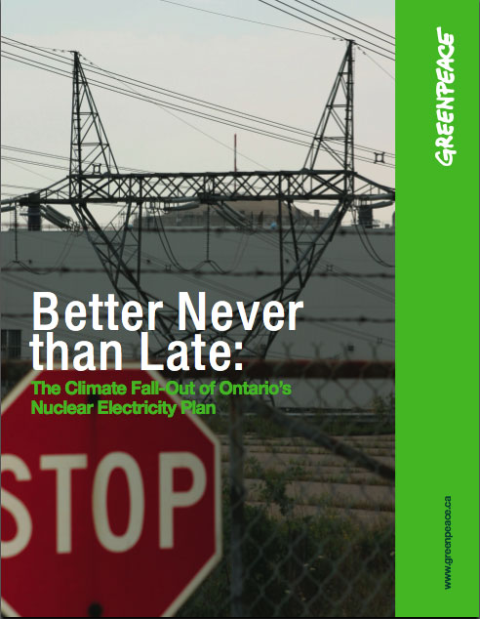Unless the McGuinty government changes its electricity strategy to one of prioritizing quick-to-deploy green energy, Ontario may fall short of meeting its greenhouse gas emission targets and drive up the risk of nuclear accidents.
Ontario’s climate plan is built on a faulty foundation: the Ontario Power Authority’s (OPA) proposed long-term electricity plan—which assumes the province’s ageing nuclear stations will operate better than they ever have historically and that a massive nuclear construction programme will be on time and on budget.
The Electricity Gap
The province’s plan to build up to 14,000 megawatts of nuclear capacity by 2025 overlooks the “electricity gap” that opens up in the years post-2010 as ageing reactors, beginning with the Pickering B nuclear station, go offline for life-extension work or permanent shutdown.
Originally it was hoped that these old reactors would retire and be replaced by new reactors built quickly to fill the gap by 2014. When it became apparent that this strategy was not realistic, however, the OPA did not change its plans. Instead of exploring a quick deployment of green energy options to address the electricity gap, the OPA remained committed to building new nuclear stations.
The OPA’s proposed plan entails three undesirable options for Ontario’s energy future:
- increased greenhouse gas emissions while reactors undergo risky life-extension repairs,
- increased greenhouse gas emissions during the wait for new nuclear stations to come online, or
- a dangerous combination of increased greenhouse gas emissions and increased risk of nuclear accidents from running ageing and deteriorating reactors after they should be shut down.
The climate fallout of Ontario’s Nuclear Electricity Plan
The OPA’s electricity plan threatens Ontario’s climate change targets in two ways: First, it underestimates future greenhouse gas emissions by drastically overestimating future nuclear performance. Second, it opts to increase greenhouse gas emissions while waiting for long lead–time nuclear stations to be built or for life- extension repairs to take place, instead of initiating quick-to-deploy energy options to fill the gap.
- Ontario will miss its 2014 greenhouse gas emissions target by 26 megatonnes (Mt)—a third of its 61 Mt target—and its 2020 target by 18 Mt, if Ontario’s nuclear reactors perform at historic levels instead of at those optimistically assumed by the OPA.
- If a decision is made to close the ageing Pickering B nuclear station, the OPA plans to increase fossil generation until new nuclear plants are built, which could lead to 21 to 55 Mt in additional cumulative greenhouse gas emissions between 2012 and 2022.
- If a decision is made to rebuild the Pickering nuclear station, the six-year construction period would result in 9–23 Mt of greenhouse gas emissions, depending on whether gas generation or imported coal is used.
Better never than late: the rising costs and accident risks of Ontario’s nuclear electricity plan
The OPA is proposing to run reactors beyond the date they would normally be shut down in order to bridge the electricity gap until new reactors come online, which would drive up the risk of nuclear accidents at Ontario’s nuclear stations. All of Ontario’s reactors are entering the most dangerous stage of their operational lives and will be more prone to unplanned shutdowns and to increased risk of accidents. Despite this, the OPA assumes that Ontario’s reactors will perform at their best historical level over the next 20 years.
New reactors cannot be built in time to fill the electricity gap or compensate for underperforming existing reactors. The OPA, meanwhile, is seeking to avoid scrutiny of its proposal to build new reactors and hopes Ontarians will forget about the delays, cost over-runs and poor performance and safety problems that have plagued Ontario’s nuclear program. Scrutiny of Ontario’s plan for new reactors is needed:
- The estimated cost for new nuclear stations has more than doubled since the OPA first released its draft electricity supply plan in 2005. The OPA has admitted that at current cost levels new nuclear stations would not be economical.
- The construction in Finland of AREVA’s EPR reactor, which is being considered for construction in Ontario, is currently three years behind schedule and $4 billion over budget.
- Nuclear life-extension projects remain risky, with no guarantee of reliable power. The life-extension of the Bruce A nuclear station is currently $300–600 million over budget. Two of the Pikering A reactors were abandoned after costs to rebuild them more than tripled, and the two Pickering A reactors that were rebuilt are operating miserably.
Keeping promises: prioritizing renewables over nuclear power
The McGuinty government has committed to greenhouse gas emissions reduction targets for 2014 and 2020. It has also stated that it will prioritize the development of renewable energy. Keeping its commitments and improving on them will require the government to dramatically increase the development of quick-to-deploy conservation and green power.
Its first opportunity to do this will be in early 2009 when it decides the fate of the Pickering B nuclear station. The OPA has given the government only bad options: either rebuilding of the Pickering B reactors, creating increased greenhouse gas emissions for the duration of the job, or shutdown of the station in 2013, using energy sources that would increase greenhouse gas emissions, until new replacement reactors come online in 2020. The government should choose neither option and direct the OPA to execute a mix of quick-to-deploy options using renewables, conservation and local generation.







